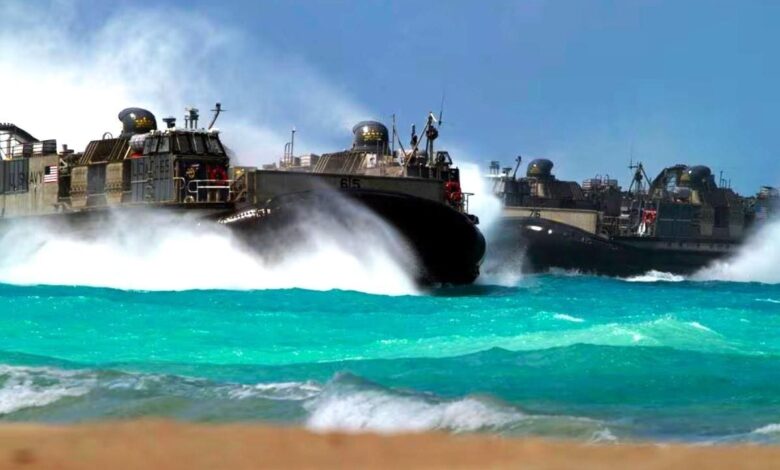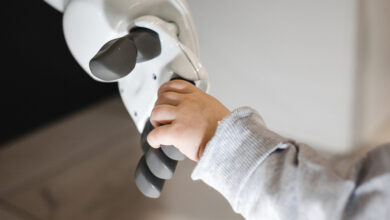U.S. Robots Could Swarm The Beaches On The Next D-Day

U.S. forces amphibious assault exercise at Marine Corps Training Area Bellow
80 years on, nobody is likely to forget the human cost of the D-Day landings. More than 4,000 allied soldiers were killed on the day itself, an indication of how intense the combat was on the Normandy beaches heavily defended by German forces. But such assaults need not involve any human casualties: an ambitious U.S. Navy program foresees a future in which Unmanned Swarming Amphibious Assault Craft (USAAC) take the beaches.
Amphibious Assault Vehicles
The LVT or Buffalo amphibious assault craft
The U.S. deployed amphibious assault vehicles as far back as in WWII, including the famous Buffalo or ‘Landing Vehicle, Tracked’ , although these were in the Pacific theater and none were present on D-Day. The Buffalo, first built in 1941, was an armored vehicle with special tracks propelling it at 8 mph in the water and 25 mph on land.
Originally conceived as a ship-to-shore transport, the Buffalo was redesigned as an armored assault vehicle, armed with two .30 machineguns. It carried 20 fully-equipped troops swiftly across the danger zone of the exposed beach under fire to positions on land where they could fight more effectively.
The Buffalos would go in the first wave, and their occupants would engage the enemy to allow conventional landing craft to drop the main body of the attacking force including tanks and heavy vehicles.
The Buffalo was superseded in the 1970s by the giant LVTP-7 able to carry twenty-five troops and equipped with water jets. However, the effectiveness of long-range anti-ship missiles seen in the 1982 Falklands Conflict made amphibious assault look increasingly dangerous. The Marine Corps increasingly focused on ‘vertical envelopment’—going from ships to land by helicopter, first attempted in Korea—rather than risky seaborne assaults.
The Marine Corps new Amphibious Combat Vehicle enters service this year
But amphibious assault is not quite dead, and after a long delay the Marine Corps will get a new Amphibious Combat Vehicle this year. The ACV has thicker armor and better armament including a 30mm cannon. The Marines originally called for a vehicle with high water speed to reduce vulnerability getting to the beach, but have settled for an initial version with a 6-mph water speed and plans for 14-16 mph in an upgraded version.
The Unmanned Swarming Amphibious Assault Craft promises a much faster attack with no human casualties.
Unmanned Swarm
Few details are available on the USAAC, which is only described briefly in the Navy’s current R&D budget in the Future Amphibious Operations section. This year the research goal is “integration and field testing of AI-enabled autonomy Command and Control.”
One of the distinguishing features of the USAAC is that “swarming” part. Rather than being controlled individually by an operator like most current uncrewed vehicles, the USAACs will move together in a coordinated group like a flock of birds or a shoal of fish. The vehicles themselves are autonomous and the operator just directs the movements of the swarm as a whole, an increasingly popular approach for deploying large numbers of military drones though so far only used in action by the IDF.
According to military news platform Sandboxx, the USAAC program has been going since 2016. In 2018 the Navy had a fleet of 13 USAAC test vehicles made from Quadski vehicles converted into drones.
The Quadski was a sophisticated recreational vehicle, a quad bike/jet ski hybrid able to speed over both land and water with ease. It could make 45 mph on land, and at a flick of a switch the wheels swiveled 90 degrees turning it into a jet ski also with a speed of 45 mph. The Quadski was built by Gibbs Sports based in Michigan from 2013 to 2016 but failed to find a market. Over 1000 were made and these are still maintained and highly sought on the secondhand market.
The Navy declines to comment on the progress of the USAAC.
QuadSki Robot Wars
Developments in Ukraine may speed the process of fielding the USAAC. The Ukrainians have used their own robotic jet skis in action and proved the value of uncrewed seacraft. They have also fielded a large number of small ground robots similar in size to the Quadski, used for kamikaze attacks carrying explosive charges and fire support armed with machine guns.
An advance guard of swarming robots landing on a beach would have several functions. They could scout out the situation, establish if a landing was feasible, and locate enemy positions before any troops landed. Like the Ukrainian robots, they could neutralize bunkers and other defensive works and engage, distract and pin down the opposition before boots hit the sand.
The robots would take heavy casualties in the process, but, being expendable, taking a bullet for their human comrades is part of their job.
This makes amphibious assault drones the sort of development that the troops landing on D-Day would have thoroughly appreciated.



